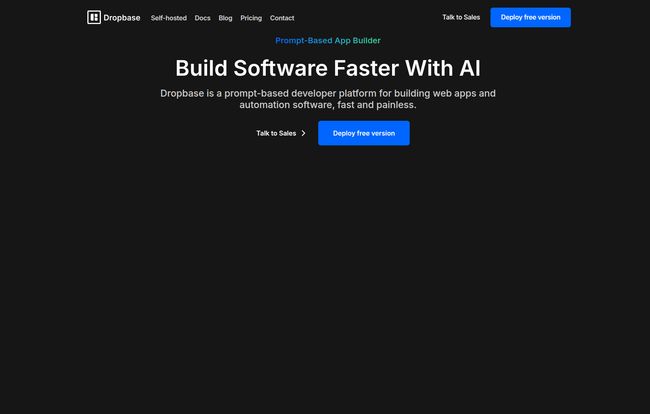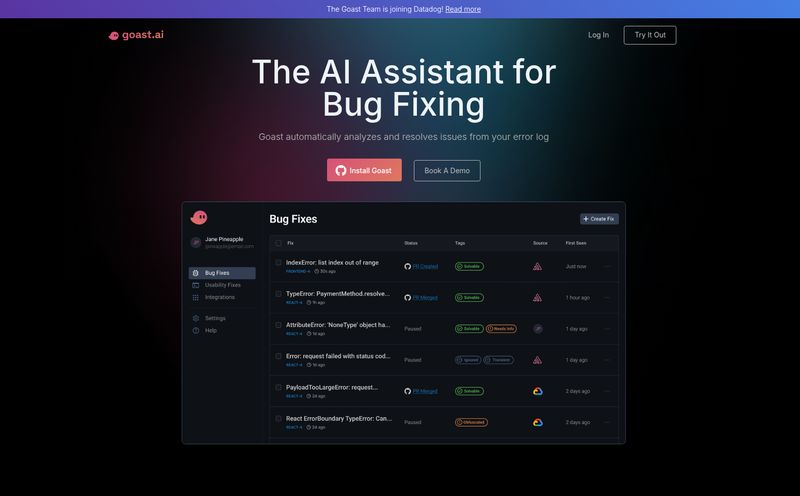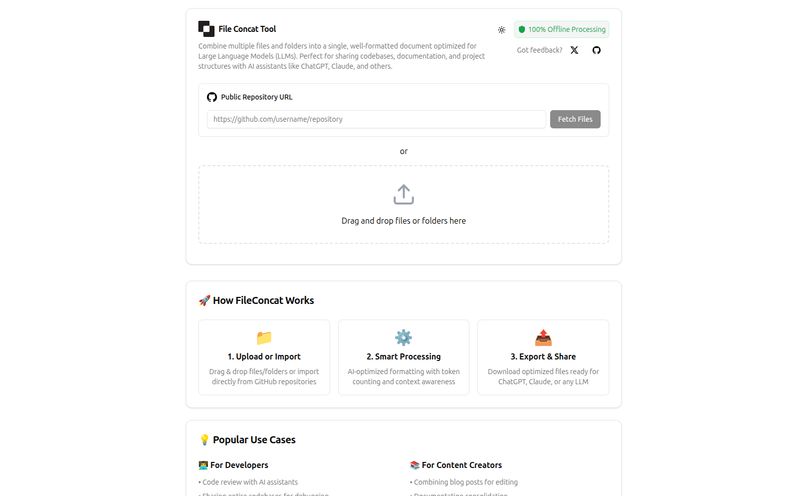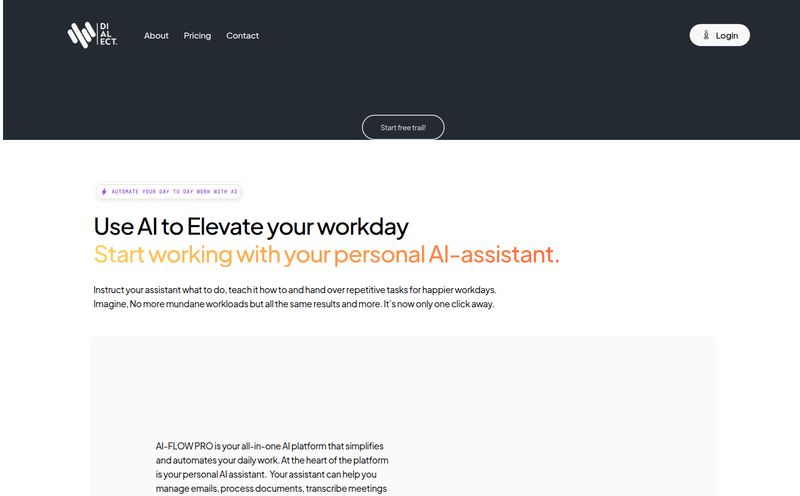There are few phrases in the tech world that produce a more collective, unified groan than, “Hey, can we build a quick internal tool for…?”
A little piece of your soul just shrivels up, doesn't it? As an SEO and traffic guy, I'm not a full-time dev, but I've been in enough sprint planning meetings to see the look on their faces. It’s the look of someone caught between two terrible choices. On one hand, you can spin up a custom app from scratch. This means weeks of coding, debugging, and maintenance, all for a tool that maybe five people will use to approve expense reports. It’s like using a sledgehammer to crack a nut.
On the other hand, you have the world of low-code/no-code builders. They promise a drag-and-drop paradise, but you often hit a wall. The moment you need a slightly custom piece of logic or a specific integration, you find yourself trapped in their pretty, padded cell. You can’t change the one thing you really need to change. It's infuriating.
So for years, we’ve just accepted this. The painful, time-consuming custom build, or the frustratingly limited no-code solution. But what if there was a third way? I’ve been hearing whispers about a tool called Dropbase that claims to be just that. It's an AI-powered platform that promises speed and flexibility. Naturally, my curiosity got the best of me.
So, What Exactly is Dropbase? (And Why Should I Care?)
At its core, Dropbase is a developer platform for building custom internal tools: think admin panels, data editors, approval dashboards, all that backend operational software that keeps a business running but no one ever sees.
But here’s the kicker. Instead of just giving you a box of pre-made LEGOs like a typical no-code builder, Dropbase gives you an AI assistant and a full toolbox. It’s built on the idea that you can describe what you want in plain English, and its AI will generate the foundation of your app for you. From there, you can tweak the UI with a simple drag-and-drop editor or—and this is the part that gets me excited—dive straight into the Python code to customize the logic to your heart's content.
It’s a hybrid approach. A beautiful, messy, wonderful hybrid. It tries to give you the speed of no-code with the power of real code. It’s for the teams who think, “I wish I could just start with a template and then rip out its guts and replace them with my own.”
The Magic Trick: How It All Works
The workflow Dropbase pushes is… well, it’s pretty slick. It feels less like traditional development and more like a conversation with a very capable, very fast junior developer.
It starts with a prompt. You literally just declare your app in natural language. Something like, “Build me a dashboard to view customer orders from Stripe and approve refunds.” Dropbase’s AI takes that, chews on it for a second, and spits out a working app. Seriously.
Of course, the first draft is never perfect, right? That’s where the human element comes in. You get this instant preview of your new app, and you can start messing with it. Don't like where that button is? Just drag it somewhere else. Need to change a table's data source? A few clicks and you're done. This is the part that feels like a classic no-code tool, and it’s great for getting the visual layout just right without writing a single line of CSS.

Visit Dropbase
But then, you hit the real meat. You can click on any component and see the code behind it. Need that button to do something super specific when clicked? You can get the code with a traceback and start editing the Python logic directly within their AI Studio. This is the escape hatch. The moment the drag-and-drop world isn't enough, you just pop the hood and get your hands dirty. You can import any Python library you want, connect to almost any API, and write complex business logic that a standard builder would laugh at.
Think of it like this: a no-code builder gives you a frozen pizza. You can add some extra cheese, maybe some pepperoni, but it's always going to be that same frozen pizza base. Dropbase gives you fresh dough, sauce, and a cheese grater, and says, “Go wild.” You can make a basic margherita in two minutes, or you can spend an hour crafting a perfect calzone with artisanal goat cheese. The choice is yours.
Where Does This Actually Fit in My Workflow?
This all sounds great in theory, but where do you actually use it? The examples on their site are refreshingly practical. No “re-imagine the paradigm of synergy” nonsense. Just real-world stuff:
- Admin Panels: The classic. A single place to manage users, view data, and perform administrative tasks without having to bug an engineer to run a script.
- Approval Dashboards: I can just see our marketing team using this for approving new ad creatives or our finance team for expense claims. Instead of a messy email chain, you get a clean, auditable workflow.
- Data Editors: Basically, a supercharged spreadsheet. You can pull in data from your production database, let non-technical users edit it in a safe, controlled way, and then write those changes back. Its a lifesaver for avoiding direct database access for the whole company.
- Cloud Consoles: A dashboard to manage your AWS, Google Cloud, or other cloud resources without having to navigate their sometimes-clunky native interfaces.
- Notification Systems: Need to trigger a Slack or SMS notification when a new user signs up or a big sale comes through? Easy peasy.
The common thread here is speed and internal focus. These are the tools that grease the wheels of a business but are often neglected because they're not customer-facing.
The Good, The Bad, and The Code-y
Alright, no tool is perfect. Let's get real about the pros and the potential snags. I’ve been doing this long enough to know there’s always a catch.
The Good Stuff
The biggest win here is the elimination of the low-code ceiling. That feeling of being trapped is gone. Because you have full access to Python, the platform's limitations are basically your own limitations. That's incredibly liberating. The development is also just plain fast. Scaffolding an entire app with a single sentence is a wild experience, and it genuinely cuts down on the most boring parts of development. I also have to give them major points for the self-hosting option. For companies with strict data privacy policies or those who just want total control over their infrastructure, this is non-negotiable. Plus, it integrates with a ton of existing tools right out of the box—Stripe, HubSpot, Salesforce, OpenAI, all the usual suspects are there.
The... Not-So-Bad Stuff (But Be Aware)
Now for the reality check. While you can get started with prompts, you'll need some coding knowledge for any serious customization. This is not your grandma's app builder. A marketing manager probably won’t be able to build a complex workflow on their own. This is a tool for developers, or at least very technical people, to move faster. Also, while the AI is impressive, it's still AI. You'll want to review the code it generates. Think of it as a brilliant but sometimes naive intern. You need to double-check its work. Lastly, the self-hosting option is a pro, but it's also a con if you're not prepared for it. It requires technical expertise to set up and maintain. If you don't know what a VPC is, you might want to wait for a potential cloud version.
Let's Talk Money: Dropbase Pricing
This is often the make-or-break part. I was pleasantly surprised here. The pricing model is straightforward and, honestly, very generous.
| Plan | Price | Best For |
|---|---|---|
| Free | $0 / month | Developers and founders getting started. You self-host it, but you get the AI Studio and can build unlimited apps. |
| Enterprise | Contact for Pricing | Organizations that need advanced security and control, with features like audit logs, SSO, and dedicated support. |
The free tier is… kinda nuts. Unlimited apps for free, as long as you host it yourself, is an incredible deal for startups, freelancers, or developers just wanting to build some side-projects. It’s not a crippled trial version; it’s the core product. I respect that a lot.
My Final, Unfiltered Thoughts
So, is Dropbase the unicorn I've been looking for? It’s getting pretty close. It's not a magic wand that removes all effort from development. It's a force multiplier. It automates the tedious 80% of building internal tools, leaving you to focus on the custom 20% that actually matters.
I see this being a massive win for startups and scale-ups where developers are stretched thin and can’t afford to spend a month building an admin panel. It's for teams who have outgrown tools like Zapier but don't want the overhead of a full custom software project. It sits in a really interesting space, competing more with developer time than with other tools like Retool or Appsmith, by changing the fundamental workflow.
If you're a developer or a technical founder who needs to build internal software, you should absolutely give Dropbase a spin. The free tier makes it a no-brainer to at least try. It might just save you from that next soul-crushing internal tool request.
Frequently Asked Questions about Dropbase
- Is Dropbase a no-code platform?
- Not exactly. It’s more of a low-code, code-friendly platform. It uses no-code elements like a drag-and-drop UI editor, but its real power comes from the ability to customize everything with Python. It's designed for developers to be more efficient.
- What kind of tools can I build with Dropbase?
- It's designed for building custom internal tools and backend software. Common examples include admin panels, approval dashboards, data editors that connect to your database, cloud consoles, and internal notification systems.
- Do I need to know Python to use Dropbase?
- To get the most out of it, yes. You can generate a basic app with a natural language prompt and make simple UI changes without code. But for any custom logic, integrations, or advanced functionality, you'll need to be comfortable writing Python.
- Is Dropbase really free?
- Yes, the self-hosted plan is completely free. It includes the AI Studio and allows for unlimited apps and users. You are just responsible for the hosting infrastructure yourself.
- How does Dropbase's AI work?
- It uses a prompt-based system. You describe the application you want to build in plain English. The AI interprets your request and generates the initial application, including the user interface and the underlying Python code, which you can then modify.
- Can I connect Dropbase to my own database?
- Yes. A key feature is its ability to integrate with your existing tools and data sources. You can connect it to databases like PostgreSQL or MySQL, as well as services like Stripe, AWS, and Salesforce.
Wrapping It Up
Look, the way we build software is changing. AI is becoming less of a gimmick and more of a legitimate copilot. Dropbase feels like a smart, practical application of that trend. It doesn’t try to replace the developer. It just tries to make their life a hell of a lot easier. And in the world of internal tools, that’s a mission I can definitely get behind.



